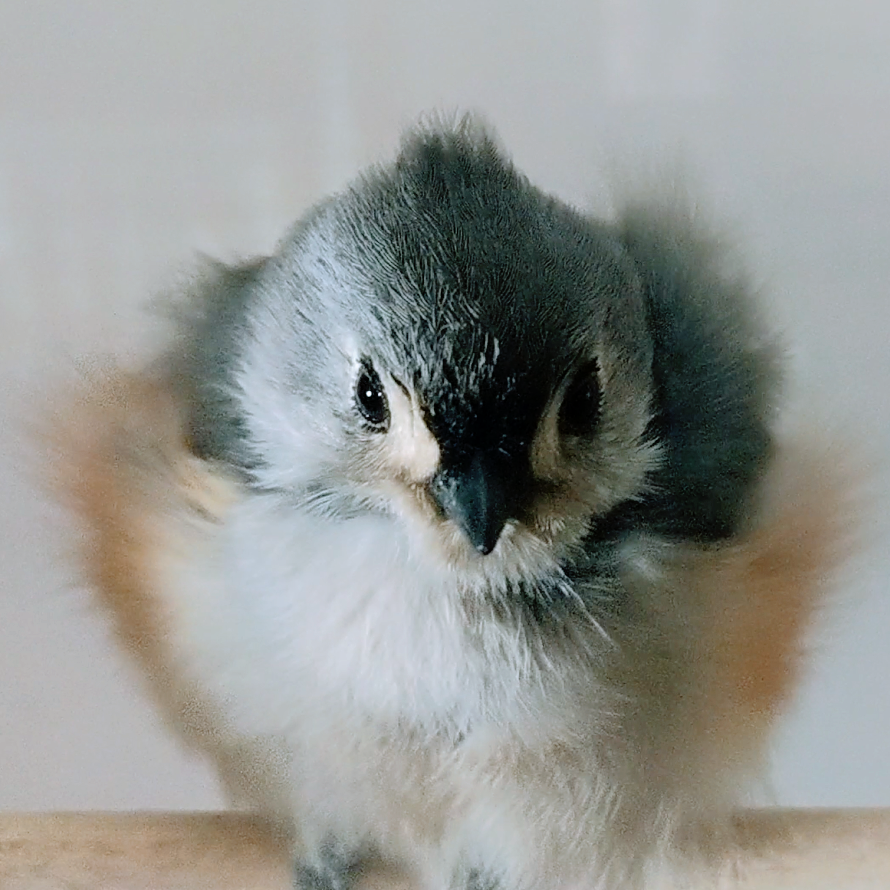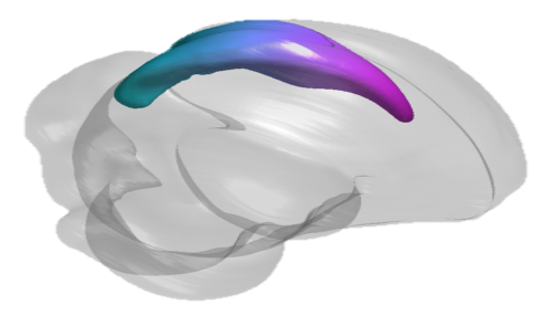
Could food-caching birds help elucidate memory formation?
An interview with Dr. Hannah Payne, Columbia University, conducted by April Cashin-Garbutt
Chickadees have exceptional memories. Instead of storing energy as fat, these food-caching birds have evolved to store food outside their body using memory. Food-caching birds have been recorded to hide thousands of seeds per day in the wild and are thought to reliably remember a large number of them.
Dr. Hannah Payne, a postdoctoral scientist at Columbia University, studies these memory specialists as they offer unprecedented access to neural circuits at precise moments of memory formation and retrieval. In her recent Emerging Neuroscientists Seminar Series (ENSS) talk at SWC, she described the discovery of spatial representations in the avian hippocampus and how her latest research is allowing her to behaviourally dissociate physical location from viewed location.
In this Q&A, Dr. Payne shares her ENSS experience, some surprising findings and the next steps for her research.
What prompted you to apply for the SWC Emerging Neuroscientists Seminar Series (ENSS)?
I’m currently on the job market and looking to start my own lab in the near future. As a senior postdoc at this stage, it is very valuable to have the opportunity to give a full research seminar. It is quite unusual to have a whole hour for a talk and to be able to meet with professors. I heard about ENSS and was excited to have the opportunity to visit SWC in person.
How useful has the experience been?
It’s been wonderful! I’ve been putting faces to a lot of names whose papers I’d read but not gotten to meet previously.
It’s also been fun to talk about several interesting ideas for future experiments. There is more than I could possibly do as a postdoc, but it’s an exciting stage because I’ll have more capacity to do multiple projects in the future in my own lab. It’s great to have ideas generated for that.
What advice would you give to those considering applying to ENSS 2024/25?
I’d say write about what you’re excited about. Write about what you really want to do, even if it seems high-risk or unusual.
Your research focuses on food-caching birds – what makes them so special and why did you choose to study them?
Food-caching birds are memory specialists. They’ve evolved to survive harsh conditions during the winter by storing food outside of their body using memory instead of as fat.
I am really excited to study them because they let us have unprecedented access to examining neural circuits at precise moments of memory formation and retrieval. This allows us to look at what’s happening in the brain when a memory is created and when you later try to recall that memory.
It’s been difficult to access this in lab animals because we can’t ask them when they’re forming a memory of a specific experience. So having this readout of seeing them hiding a seed and later going back to retrieve it – many times – is a new approach to studying how the brain forms this type of memory.

How many food items are food-caching birds able to store and retrieve across their environments?
There are several types of food-caching birds in a couple different families, but some species have been recorded in the wild to hide as many as thousands of seeds in a single day when food is available.
If food is highly available, they’ll cache way more than they need. Whereas if food is less available, they’ll cache a smaller amount, but then they’ll remember those locations more reliably.
In the lab, they’ll typically cache about 100 seeds in a single, couple-hour session.
Why do you focus on the black-capped chickadee and tufted titmouse?
The main reason we chose those species is because they live in New York. And there was a large body of mainly behavioural studies on black-capped chickadees in the past, so a lot is known about their behaviour. For example, we know the hippocampus is necessary for accurate retrieval of caches.
We initially also worked with the tufted titmouse, because they are bigger, but we are now focusing on the black-capped chickadee to keep things simple. Both species cache food, are closely related, and have similar neural activity in their hippocampus so they are quite comparable.
What spatial representations have you found in the avian hippocampus? What differences did you find between the posterior and anterior hippocampus and how can this be explained in terms of development?
The main discovery from my published work is that there are place cells in birds. Place cells are neurons that only fire when an animal is in a certain region of space, originally described in rats by John O’Keefe in 1971. A population of place cells will tile an environment, so that the animal’s spatial location can be read out from the neural activity.

Previously it was thought that the hippocampus of birds and mammals was very different, and that birds lacked place cells. But we found that there are robust place cells in the hippocampus of food-caching birds. Overall, about 70% of excitatory cells significantly represent the animal’s own location in space!
The anatomical pattern we found was that these place cells are mostly located in the anterior hippocampus of birds, which seems to correspond to the dorsal hippocampus in rodents, where more place cells are found. Because the hippocampus develops from the same part of the neural tube in both mammals and birds, this result indicates that this organisation of the hippocampus is really functionally conserved.
Were you surprised by this finding?
It was a surprise! Previous recordings in the hippocampus of pigeons and quails had not reported anything that looked like place cells. And the hippocampus looks very different in birds and mammals. But our results indicate that the way that the brain represents space is shared, despite 300 million years of independent evolution.
Regarding the anatomical pattern, there was one other group that predicted this by looking at the stress response and anatomical connectivity of the avian hippocampus with regions like the amygdala. And it turns out that those pathways are also preserved in birds and mammals. But no one had realised this pattern might transfer to spatial coding as well.


In what ways did the spatial codes of food-caching birds differ to species that don’t cache food?
Spatial coding in the food-caching bird was more extensive and refined compared to a species that did not cache food.
We’ve only looked at a couple of species, so we can’t say for sure this is true across all food-caching and non-food-caching species. But I think it does help explain why people might have missed this previously – because you not only have to be in the right part of the hippocampus, but it also helps to be in the right species.
What surprising similarities did you find between birds and mammals?
The other surprising thing we found is that not only are there place cells in the hippocampus, but also sharp wave ripples. These are large population events, bursts of activity that are synchronised across the population which are thought to be important for the consolidation of memories. You especially see them during sleep or rest – during offline activity when an animal is resting.
This was especially surprising because the detailed organisation of cells in the hippocampus is really different between mammals and birds. For example, there is no pyramidal cell layer in the bird hippocampus, a dense layer of cells seen in mammals.
We were surprised to see sharp wave ripples despite these differences in anatomy. I can speculate that they still appear due to the pattern of inputs that are active during sharp wave ripples.
At a big picture level, both place cells and sharp wave ripples are surprisingly similar across mammals and birds – so despite the differences between the hippocampi in mammals and birds, the basic blueprint for this circuit may be much older than we thought.

How much do birds rely on vision to navigate? Are they similar to humans in this way?
Birds rely very heavily on vision to navigate and in that sense they are more similar to how we navigate and explore our environment, or how we rely very heavily on vision to decide where to go next.
Birds have very high acuity vision because, like us, they have foveas, which are regions of high acuity in the centre of the retina. And if you ever see a bird looking a bit frantic, moving its head around, that’s because they’re directing their gaze using head movements rather than eye movements. They have extra vertebrae in their neck, so they’re particularly flexible.
How have you developed a system to study the representations of physical versus viewed locations?
For this second project I set up a technique I used in grad school, which is called video oculography or video eye tracking. This system let us determine that these birds don’t move their eyes that much! We can then just track their head and estimate where they’re looking based on head movements alone.
I track the head during a simple foraging task, but it’s a visually guided task so they have to look around their environment to find a light that turns on when food is available. They then navigate to that location.
What have been your key findings so far?
We found that surprisingly, if a place cell is active when a bird goes to a certain location, that same place cell is also active when the bird simply looks at that location from afar.
So it seems like these place codes that I described in my first project can be flexibly reactivated by viewing a location rather than physically visiting it.
How do the codes for physical and viewed locations co-exist without birds getting confused?
These representations seem to trade off at a very fast timescale between representing the bird’s own location – where it currently is – and representing where it’s looking in the environment. So when they’re physically moving, we mainly see representations of place, whereas when they’re sitting still but visually exploring – looking around – we mainly see representations of where they’re looking.
Do your findings have any implications for understanding episodic memory in humans?
That’s really the motivation behind this work, to eventually understand episodic memory in humans. The fact that these birds are very visual, and also display this remarkable food-caching behaviour in which we can look at what is happening in the brain when the memory is formed and when it’s later retrieved, will help us understand how the brain is forming episodic memories across species.
What is the next piece of the puzzle your research is going to focus on?
The next piece of the puzzle is to combine ongoing work in the Aronov lab – looking at activity during caching – with my results about how visual targets are represented in the hippocampus.
The exciting question is, can caches be represented remotely by looking rather than by physically visiting?

About Dr. Payne
Hannah Payne is a postdoctoral researcher in the Aronov lab at Columbia University. Her graduate studies with Jennifer Raymond at Stanford University examined how the cerebellum learns to control eye movements. As a postdoc, Hannah has combined her interests in vision and learning to investigate visual and physical codes for space in food-caching birds, with the goal of leveraging innate food-caching behaviour to understand how perception and memory interact in hippocampal circuits.


